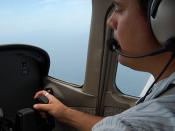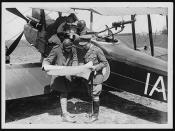TABLE OF CONTENTS
ABSTRACT 4
INTRODUCTION 5
Background 5
Purpose/Audience 5
Sources 5
Limitaions 5
Scope 5
COLLECTED DATA 5
Importance of Communication Among the Crew 5
Main Cause of Aircraft Accidents 6
Duties of the Crew Members 7
Expectations of the Crew 7
The Crew is a Team 8
Intimidatin in the Cockpit 8
Cabin Crew is a part of the Team 9
Trusting the Crew's Judgment 9
Crew Resource Management (CRM) 9
Outline of CRM Training 10
LOFT Training 10
Organizing Resources and Priorities 11
CONCLUSION 11
Summary of Findings 11
Interpretation of Findings 11
REFERENCES 13
ABSTRACT
The majority of aircraft accidents are caused by human error, and an accident or incident is linked together by a chain of errors. Most of these accidents could have been avoided by the crew if they would have been communicating to each other better. Some common errors that occur among the crew are poor task delegation, assertiveness, and distractions.
Crew training in communication and teamwork will increase the crews' performance level. Programs like Crew Resource Management (CRM) have been developed to try to help the crews work together and reduce the human factor in accidents. CRM includes training in leadership/followership, assertiveness, management, communication, teamwork, decision making, and task delegation. Through programs like CRM crews learn to work together as a team, and when they are working together it is less likely there'll be an accident.
INTORDUCTION
Background
The cause for most aircraft accidents (65%) are by crew error (FAA News, 1996). When the Crews performance level is low due to poor teamwork and communication this is when accidents happen. How can crew error be reduced? Even though human error can't be reduced completely through constant training and effort by the crew performance will increase and accidents will be reduced.
Purpose/Audience
This report is intended for a general audience and will show how important it is for the flight and cabin crew to work together and communicate as a team. This report will also examine the CRM program.
Sources
Sources have been obtained for this report from the Internet and from the Waldo Library, Western Michigan University, Kalamazoo, Michigan.
Scope
Teamwork and communication are a critical factor in the crew's operation of aircraft. Accidents can be prevented when these two factors are considered.
COLLECTED DATA
Importance of Communication amoung the Crew
People communicate to each other every day. From a kids talking to their parents about their report card, to doctors working in an operating room. In order for us to understand one another we must be clear in what we say. For instance, if a doctor tells a nurse to pull a certain plug on a machine, he'd better be clear on what he says or the nurse might end up harming a patient. Likewise, the cabin and flight crew must work together.
In a typical cockpit the flight crew is very busy, and they need to be well organized to handle the many tasks they perform. They need to communicate properly and clearly for safe operations, if they don't their actions could result in a tragedy.
Main Cause of Aircraft Accidents
Mechanical problems and technical malfunctions do contribute to aircraft accidents, but human error is the main cause, accounting for 65% of the accidents (FAA News, 1996). See the pie chart in figure 1. This figure is quit high, and if it were possible to reduce human error the accident rate would drop significantly. Accidents that occur because of human error are not a direct result of just one error but of a chain of errors. The human error chain results when one bad decision leads to another which leads to the accident. The question is, how can we reduce human error in the cockpit? Studies have shown that most incidents could have been prevented if communication and leadership skills were improved.
Pie Chart figure 1:
Duties of Crew Members
In order to have a clear understanding of who's involved in the crew, these positions with their duties will be discussed. There are usually 2-3 flight crew members and 1-3 flight attendants aboard an airliner. In the flight deck are the Captain, Co-pilot and flight engineer. When there are only two flight crew members there's no flight engineer. (this is to reduce costs). The Captain is the Pilot in Command (PIC). He/she has the final authority of all decisions and all responsibility rest on his/her shoulders. The Co-pilot assists the Captain in his/her duties, like calculating fuel consumptions, weight and balance, navigation etc. He/she is Second in Command (SIC). The Flight Engineer helps reduce the work load of the Captain and Co-pilot. Some of his/her duties may include fuel consumption rate, weight and balance, and communicating with the cabin crew. The cabin crew consists of the Flight Attendants. Besides serving coffee and making sure passengers are comfortable, they are also responsible for briefing passengers on emergency procedures, evacuations, and informing the flight crew when problems arise. Flight Attendants are very important and are an asset to the crew as a whole.
Expectations of the Crew
Many aircraft accidents have occurred because of role confusion amoung the crew. It is crucial that each member knows what their job is, and what is expected of them. A way for them to know is through communication. An example of miscommunication is the Avianca jet that was in the pattern for over an hour waiting to land at Kennedy Airport. The flight crew had told Air Traffic Control (ATC) they were low on fuel and would run out if they did not land soon. The plane crashed on final approach to land, the reason: fuel exhaustion (Nader & Smith, 1994). The crew didn't declare an emergency to ATC. In aviation saying the right key words can make a difference. Had the pilots declared an emergency because of the low fuel level ATC would have cleared them to land earlier. Or if ATC inquired about their fuel situation, the accident wouldn't have happened. This accident also shows the human error chain. One mistake leads to another which leads to an accident..
A Crew is A Team
The words Crew and Team have the same meaning: A group of people working together. The flight & cabin crew are a team and each crew member is a team player. A military phrase heard often is 'there are no individuals here! You are a team!' It should be the same way aboard an aircraft. In order for flights to be safe, efficient and enjoyable the crew needs to be able to work together. It's not enough for the Captain to give orders and the crew obey no matter what, there needs to be open communication.
Intimidation in the Cockpit
The Captain is the commander on board but this doesn't mean he can't listen of take advice. Each member of the 'team' is interdependent on one another. Sometimes in aviation the Captain is thought of as 'god', you don't dare approach him or question him. A lot of cabin and flight crews are afraid to approach the Captain about a safety concern for fear of how he'll react. Slowly this attitude has been changing. How can a cockpit be effectively run if the Captain's own crew can not work together?
One example of how these attitudes can affect the way hazardous situations are handled is the Air Ontario flight from Dryden, Canada. The airliner had been waiting along time for it's turn to takeoff. The weather was bad, it was snowing hard and the visibility was low. The last time the plane was de-iced was a half-hour ago. From the pilots view out the window everything looked normal. Meanwhile, a flight attendant noticed the snow that was accumulating on the aircraft's wings. She wanted to inform the flight crew before takeoff but was intimidated by what their response would be to her, so she said nothing. There was also an airline pilot aboard who wasn't on duty at the time, but was also concerned about ice forming on the wings. He thought about letting the flight crew know what he saw, but didn't want to interfere with their operations. The Air Canada barely took off when it crashed because ice had built on the wings causing loss of lift (Chute & Wiener, 1996).
Cabin Crew is part of the Team
Here again is the human error chain. If one of the links could have been broken the accident wouldn't have happened. These attitudes can and do cause harm. The flight attendant and off duty pilot should have informed the crew of the possible danger and the Captain should have requested another de-icing before takeoff. The crew should welcome the cabin crew on their concerns, after all they too are a part of the team.
Trusting the Crew's Judgment
Trusting each other's judgement is a necessity. Without it, how can the crew work together? The Captain must be able to trust that his/her crew are performing their duties properly and vise/versa. Besides having authority the Captain is also the leader. He/she is the one when emergency situations arise pulls the crew together to work as a team even when they don't know each other. A true leader is willing to listen to others, be respectful and be able to take command.
Crew Resource Management (CRM)
A program called Crew Resource Management (CRM) has been developed to help implement these leadership, communication and decision making skills in crew members. Since the main cause of accidents is due to human error it is hoped that through CRM training crew membfers will communicate and work together more effectively. CRM is not required by the FAA, but it is recommended. Many airlines are having their crews go through this training and they look highly on pilots who not only posse the technical skills but also the people skills.
Outline of CRM Training
In years past emphasis was put on the technical, stick and rudder aspects of flying. In recent years it has become evident that these skills by themselves are not enough, but that training in people skills is needed. That is what CRM is about. It provides crews' training in:
1. Communication.
2. Decision making.
3. Assertiveness.
4. Leadership/Followership.
5. Teamwork.
6. Task Delegation.
7. Managing.
Crew members going through CRM training will attend classroom instruction, watch video's and participate in role playing on these subjects (FAA- AC, 1995).
LOFT Training
Because crews rarely work together more than once and dont't have time to build a commrodery, using the Line Oriented Flight Training (LOFT) simulator crews practice managing a cockpit with members they've never met (Chute & Wiener I,1996). This simulator is like virtual reality. Pilots sit in a cockpit where the windows are where the video screen is, all the buttons and knobs work. (Pilot have come out of these LOFT simulators sweating, because what they've just experienced seemed so real). In LOFT crews can fly routes and have emergency situations come up, like an engine failure, deteriorating weather, and navigation problems. The benifit about LOFT is that it's a simulator, there's no danger involved and yet the crew still learns (Helmreich, 1996). Crews going through LOFT training are evaluated on how well they handled the different situations, communication with each other and task delegation. These training sessions are vidio taped so the crew can debrief afterwards how well they did and what they need to change.
Organize Resources and Priorities
Crew members are not only leaders but also managers. They must be able to use their time and resources wisely. Thers's only so many tasks that one person can handle and be efficient at the same time. That's why Captains need to know when to delegate duties and when to notice that another has to many. Also, They need to prioritise, know what duties are the most important and when they need to be done. This is all part of being a leader and manager.
CONCLUSION
Summary of Findings
Human error is the main cause of aircraft accidents, and it's a chain of errors that sets the accident into motion. Poor flight and cabin crew communication does exist. A program called Crew Resource Management has been developed to improve teamwork, proper task delegation, communication, and trust among the crew.Interpretation of the Findings
The need for crew communication is evident. When crews' don't work together their performance level is low and this is when they are volnerable to accidents.
Programs like CRM are very helpful in instilling these principles and breaking the bad habits. Poor attitiudes and habits can't be changed overnight. That's why there is a need for recurrent CRM training. Communicaiton and teamwork is the key to safe and effective operations. There's no 'I' in CREW but there is 'WE'.
REFERENCES
Chute, R. D. & Wiener, E. L. 'Cockpit/cabin communication: I. A tale of two cultures.' [http://olias.arc.nasa.gov/personnel/people/RebeccaChute/JA1.htm.]. Oct 1996.
Federal Aviation Administration. (1995) Crew resource management training (AFS-210, AC no. 120-51B). Washington, D. C.
Nader, R. & Smith, W. J. (1994). Collision course: The truth about airline safety. PA: TAB Books.
FAA News. 'Atlantic coast airlines first to use FAA crew performance program.' [http://www.dot.gov/affairs/apa15596.htm]. Sept 1996.
Helmreich, R. L. 'The evolution of crew resource management.' [http://www.psy.utexas.edu/psy/helmreich/iata96/htm]. Oct 1996.
Chute, R. D. & Wiener, E. L. (1996). Cockpit-cabin communicaiton: II. shall we tell the pilot? The International Journal of Aviaiton Phychology, 6 (3), 211-229


